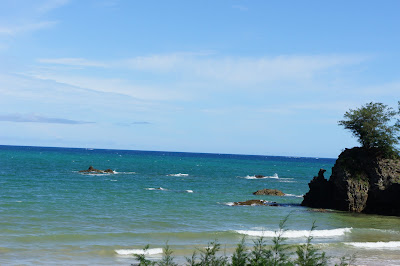
With author Yuki Tanaka's permission, here is the text of his talk on July 13 for the group of lawyers in Hiroshima working for nuclear weapons abolition, in Japanese. (Photo: Yuki Tanaka speaking at the workshop "Atomic Bombing and Indiscriminate Attacks Against Civilians, at Riverside Church, on May 1, 2010 as part of the two-day NGO Conference preceding the UN NPT Conference.)
「2010 NPT 再検討会議」の結果とオバマ政権の核政策批判
− 今後の核廃絶運動の展望に向けて —
田中利幸
広島平和研究所 教授
「核廃絶をめざすヒロシマの会」運営委員
2010年7月13日 広島弁護士会平和・憲法問題対策委員会向け講演ノート
A) NPT再検討会議の失敗
ブッシュ政権によるCTBTの批准拒否、ABM条約からの脱退、新型核兵器の開発という米国の核兵器拡大政策と「対テロ戦争」遂行政策という影響をもろに受けてNPT再検討会議が大失敗に終わった5年前と比較して、今回は、昨年4月5日のオバマ大統領のプラハ演説による核軍縮政策の提唱と、それに続く米露間の核削減にむけての具体的交渉の推進、オバマのノーベル平和賞受賞といった比較的明るい条件のために、今年のNPT再検討では核廃絶という最終目的に向けて、なんらかの進展が見られるのではないかという期待が一般に強かった。とくに、「核兵器禁止条約 Nuclear Weapons Convention(以下NWCと略)」の早期締結をこの数年強く訴えてきた市民社会側としては、NWCの設定に向けて、今回の再検討会議では、かなりの進展があるのではないかという希望的な観測を持っていた。
例えば、今年2月に長崎市で開催された「第4回 核兵器廃絶・地球市民集会ナガサキ」で採択された長崎アピール2010においても、再検討会議に向けてNWCの必要性について次のように言及された。
「核兵器を禁止し、廃絶する条約の準備のために話し合うことを目的として、志を同じくする国家と市民社会の代表が参加するプロセスを創り出そう。そのようなプロセスは潘基文国連事務総長が提案した5項目提案
*を手掛かりとすべきである。この提案には核兵器禁止条約又は諸条約の枠組みについて話し合いを始めるように求めた呼びかけも含まれる。」
*(1)核不拡散条約(NPT)加盟国に核軍縮交渉を誠実に行うよう求める
(2)安保理が核軍縮首脳会議の開催など軍縮プロセスを強化する措置を検討する
(3)非核地帯条約など多国間条約を普及する
(4)核兵器保有国の責務と公開性の増進
(5)その他の大量破壊兵器の廃絶、ミサイル・宇宙兵器通常兵器の制限
5月初旬、実際に再検討会議が開かれ、「最終文書」に含むべき事項についての議論が始まると、期待していたごとくNWCの必要性を訴える声が聞かれるようになり、5月14日段階での主委員会Iの議長草案にはNWCに関して次のような明確な提言が含まれた。すなわち、「核兵器国は核軍縮の最終段 階と核兵器のない世界の維持に必要な法的枠組みを確立するために特別の努力を払うべきである。この目的には、国連事務総長の5項目提案、とりわけ核兵器禁止条約や相互に補強し合う条約の枠組みが役立つ」(強調—田中)のであり、「核兵器国は(戦術核を含めた核軍縮、非核国に配備された核兵器の問題など)7項目を含む具体的措置について2011年までに協議し、その結果を2012年の準備委員会に報告すべきである。この協議を踏まえて、国連事務総長は時間枠を決めて核兵器を完全廃棄するためのロードマップに合意する方法と手段について協議する国際会議を2014年に招集すべきである」(強調−田中)というものであった。
ところが、日が経つごとに草案の内容が骨抜きにされ、核兵器禁止条約実に向けて当初設定されていた明確な期限が外されてしまった。しかも、さらに、米露仏英の核大国は、具体的期限を取り除いてしまった「核軍縮過程の最終段階や関連措置は期限を決めた法的枠組みで追求する必要があることを確認する」という修正表現にすら反対。米英仏は「期限をきめた」という文言の削除を求め、ロシアは全文の削除を求めた。これに対して新アジェンダ連合国などからの巻き返し活動がみられたものの、結局、最終文書は我々が当初期待していたものとは極めて遠いものとなってしまった。すなわち、NPT再検討会議は、「核兵器のない世界を実現、維持する上で必要な枠組みを確立すべく、全ての加盟国が特別な努力を払うことの必要性を強調する。同会議は、国連事務総長による核軍縮のための5項目提案、とりわけ同提案が強固な検証システムに裏打ちされた、核兵器禁止条約についての交渉、あるいは相互に補強しあう別々の条約の枠組みに関する合意の検討を提案したことに留意する」、というものである。明確な期限としては、「核兵器国は、条規の履行状況について、2014年の準備委員会に報告するよう求められる」というものだけになってしまった。
これまでNPT再検討会議の最終文書でNWCについて言及されたことはなく、今回が初めてであったため、これを比較的高く評価するような論評が市民社会の側にも見られるのであるが、果たしてこれがそれほどまでに評価されるべき事柄であろうか。10年前の2000年NPT再検討会議の最終文書と比較してみれば、ほとんど何も進展が見られないのは明らかであり、いったいこの10年間、核兵器国は言うまでもなく、各国政府と我々市民社会も何をしてきたのかと、自己批判的に問わなければならない状況にある。その意味で、私は、今回のNPT再検討会議は明らかに失敗に終わったと判断すべきだと考えている。
B) 失敗の一原因=オバマ政権の核・軍事政策に対する分析と警告の甘さ
NPT再検討会議への期待過剰、すなわち判断の誤りは、オバマ大統領が創り出した「核兵器廃絶目標に向けての世界的コンセンサス」という神話に市民社会が踊らされ、なにか具体的な変革の兆しが見えてくるのではないかという幻想を我々がもってしまったことに、かなりの原因があるように私には思える。その典型的な一例が、広島市長秋葉忠利氏が率先してすすめてきた「オバマジョリティー」という運動であろう。「核廃絶の夢」をプラハ演説でぶち上げたオバマを、税金を使ってまで「オバマジョリティー」という造語を市職員の名札に付けさせ、ポスターやTシャツまで作ってオバマを賛美し、オバマを支持すれば核軍縮や核廃絶に容易につながってくるはずという幻想を産み出した市長の罪は決して軽くはない。しかし、こうした幻想にとらわれたのは広島市民だけではなく、程度の差はあれ、世界各国の反核平和活動家の中にもかなり広く見られた現象であった。
オバマの「核廃絶の夢」が、「夢」どころか、いかに内実を伴わない、人を惑わす「幻想」であるかは、NPT再検討会議の数ヶ月前からオバマ政権が次々と発表してきた幾つかの重要な関連政策内容を客観的に分析してみれば自明なのであるが、なぜか、私自身を含め市民社会の側で、この点についてNPT再検討会議前に強く批判を展開し、市民に警告を発することを怠ってしまった。(この点、私自身もオバマ批判が甘かったと反省している次第である。)
その重要事項とは、
(1)昨年10月末にオバマが署名した2010年度核兵器関連予算の額と内容
(2)今年2月にオバマが出した2011年度核兵器関連予算の要求額と内容
(3)今年4月に発表された米国政府の「核体勢見直し Nuclear Posture Review(以下NPRと略)の内容
(4)2010年度国防費ならびに2011年度国防費要求額の驚くべき増加と、非核兵器戦略である「即時世界攻撃Prompt Global Strike(以下PGSと略)」の内容
(5)オバマのアフガン戦争政策
(6)オバマ政権のNPT非加盟国である核兵器国、すなわちイスラエル、インド、パキスタンに対する姿勢と、それと密接に関連する対イラン政策
(7)オバマの日米安保同盟政策と米軍基地問題に対する姿勢
(8)オバマの北朝鮮に対する姿勢
時間的制約から各項目を詳細に説明している余裕がないので、できるだけ簡潔に述べるが、これらを総体的に見てみれば、オバマの「核削減」政策の背後にある実相が明らかになる。
C) オバマ政権の核兵器関連予算の実態とNPR
オバマが大統領に就任して間もなくの昨年2月末に出された2010会計年度予算教書では、ブッシュ前政権が2006年に着手したが08年以降は議会の反対で凍結されている「信頼性代替核弾頭 (PRW)」(=長期保管・配備可能な高性能小型核弾頭)開発計画を、引き続き凍結すると発表。しかし、それに代わる措置として、「寿命延長計画(LEP)」(=老朽化し、2040年までに寿命を終える現存の核兵器を、単純で堅牢な新型弾頭で置き換えるという計画)の継続を提案した。この提案に基づいて昨年5月にエネルギー省が議会に提出した核兵器関連予算の説明では、「現在の能力の維持」を計りつつも、「今後の核戦略政策決定により変動する」こともあるというフレキシブルな方針が明らかにされた。
その結果、昨年10月末にオバマが署名した核兵器関連予算額は前年と同水準の63.8億ドル(約6千4百億円)とされた。そのうち、「核兵器備蓄活動」には総額約15億ドルが当てられたが、その中には、トライデント潜水艦発射弾道ミサイル用核弾頭W76のLEPプログラム(2億2320万ドル)、爆撃機・戦闘機搭載用B61核爆弾の非核部品に関する研究(3250万ドル)、新しいプルトニュウム生産施設であるロスアラモスの化学冶金施設建替え計画第1段階(9700万ドル)、核弾頭の2次爆発部分を組み立てるオークリッジのY-12ウラニュウム処理施設設計費(1億0600万ドル)などが含まれていた。
今年2月に出した2011年度の核兵器関連予算要求額は、今年度より9.8パーセントも増額の70.1億ドルである。その中には、化学冶金施設建替え計画第2段階(2億2500万ドル=今年度予算の2.3倍)、Y-12ウラニュウム処理施設建設(1億1900万ドル、さらに2012−15年の4年間で8億8500万ドルを投入する予定)、巡航ミサイル用核弾頭W80のLEPプログラム(3400万ドル)が含まれている。さらには、長距離飛行爆撃機搭載用の核弾頭搭載可能な新しいクルーズミサイル開発のための必要予算が8億ドルと見込んでおり、来年度はその最初の研究プロジェクトのために363万ドルを要求している。年間70億ドルという予算額は、前ブッシュ政権の予算額をはるかに超える史上最大の核兵器関連予算である。
長期計画によると、核兵器関連予算の総額として、2015年まで毎年平均3億ドルづつの増額を見込んでいる。今後10年間では、核兵器と関連施設の近代化のために800億ドル、運搬手段の近代化のために1000億ドル、合計1800億ドルという膨大な金額を投入する計画とのこと。しかも、その使途内容は、ブッシュ前政権が着手した「信頼性代替核弾頭 (PRW)」開発プログラムの事実上の復活に直結するようなものが多いのである。つまり、米露核削減交渉で作戦配備用の戦略核弾頭の数は大幅に減らすが、備蓄用の核兵器を維持するだけではなく、それらを高性能なものに取り替えて行こうという意図がここには明らかに見えるのである。「新しい核兵器の開発はしない」と繰り返し述べているオバマであるが、実質的には、それと同じようなプログラムを多額の予算で進めているのが実情である。すなわち、オバマがプラハ演説で「我々は安全かつ効果的な(核)兵器を維持して敵に対する抑止力を保つ」と述べた、その具体的な姿がここに如実に現れているのである。
したがって、2月に出たこの核兵器関連予算要求額の詳細を見てみれば、4月6日に出されたNPRの内容は、2月段階で容易に推測できるものであった。NPRでは、核弾頭の削減を一方で強調しながらも、核抑止力の維持と、小規模ながら高性能で高能力(“smaller and highly capable”)の核兵器攻撃力という点が幾度も強調されている。核攻撃の対象となりうるのは、他の核兵器保有国、NPT非加盟国、そしてNPTに違反する国家とされており、核兵器保有国の中に北朝鮮、NPTに違反する可能性のある国としてイランやシリアが想定されているのである。しかも、「核兵器を持たないイラン対ししては、必要な場合には、核先制攻撃もありうる」というのが国防省の方針であり、オバマの「核抑止力にのみ限定」という公式政策と矛盾する。では、オバマがプラハで格調高く唱えた「核廃絶の目的」はどうなったのか。この問いに対して、エネルギー省のある高官は、NPRの中には、大統領の最終目的に向けての「全般的に哲学的な一歩が含まれている(There is this overall philosophical step)」と説明している。「哲学的一歩」とは、アメリカの官僚が産み出すなんとも巧妙な表現であるが、これは「具体的なものは何もない」ということの口実でしかない。
D) 増大する軍事予算と戦費=オバマ政権の軍事戦略の実相
増大したのは核兵器関連予算だけではない。2010年度に国防省に配分された予算額は6800億ドル(約61兆円 比較:日本の国家予算85兆円)であるが、これがアメリカが使う軍事費の総額ではない。この数字には、前述の核兵器関連予算や、国内警備関連予算、情報収集関連予算、退役軍人年金など諸々の国防省以外に配分されている予算は含まれていない。したがって、実質的には、アメリカの軍事支出は国防省予算の倍額になると言われている。その上、アフガニスタンでの戦費200億ドルもまた、これとは別建ての予算である。2009年ブッシュ政権下での国防省予算・核兵器関連予算・戦費の合計が6810億ドルであったので、今年度のオバマ政権の軍事費は、それをはるかに超える金額となっている。2011年度国防省予算として、オバマは7080億ドルを要求している。かくして、実に皮肉なことに、ノーベル平和賞を授与された大統領の下で、軍事費が史上最大のものとなっているのである。
なぜこれほどまでに多額の軍事費が必要なのか。それを理解するためには、4年ごとに国防省が発表する『Quadrennial Defense Review (以下QDRと略)』を見てみる必要がある。最も最近のQDRは今年2月に出されている。それによれば、現在、世界中に1千以上の数に上る米軍基地が存在し、常にこれらの基地設備がアップグレードされているのみならず、基地の数も増加している。例えば、つい最近、南米コロンビアには6つの新しい基地が設置された。アメリカの目的は言うまでもなく、これらの基地を活用しての「世界支配」である。国防長官ゲーツは、このQDRの中で、「我々の最優先事項は、アフガニスタン、パキスタン、イラク、イエメンでの現在の戦争に勝利すること」であり、「将来の戦争の成功は、現在のこれらの戦争が成功するかどうかにかかっている」と述べている(強調—田中)。
「将来の戦争 “wars to come”」とはいったいどんな戦争を想定しているのであろうか。最大の仮想敵国は中国とロシア、とくに中国であることが、QDRには明確に述べられている。核兵器を使わないとしても、最新の航空宇宙技術とミサイル防衛システムで中国とロシアを封じ込めるという戦略であり、この戦略の背後には、ますます減少していく石油をはじめとする資源供給源の支配という目的がある(詳しくは、ブルース・ギャグノン著「宇宙的視野から核兵器廃絶の展望を考える」私と藤岡惇の共訳『世界』2010年6月号参照)。資源供給源の確保と支配の目的のためには、世界のどの地域であろうとも、必要であれば、航空宇宙技術と長距離ミサイル攻撃システムを駆使して1時間以内で壊滅的な攻撃を敵に加えることができるシステム、「即時世界攻撃Prompt Global Strike(PGS)」と呼ばれるシステムを構築することをアメリカは目下企てている。このPGS開発研究のために、オバマ政権は2億4千万ドルを2011年度要求予算の中に含ませている。
すなわち、高性能・高能力核兵器攻撃力維持とPGSは、オバマ政権の軍事戦略の2つの柱をなすものであって、その2つは相互に補完し合っている重要不可欠な戦略として認識され位置づけられていることを、我々は忘れてはならない。核兵器もPGSも、「抑止力」だけではなく、明らかに「攻撃力」としてとらえられているのである。
アフガニスタンにおける戦争も、本質的には、アルカイダやタリバンという「テロ集団」に対する戦争という背後に、中央アジアにおける石油資源供給源の確保・支配というアメリカの野望があることはあらためて説明するまでもないであろう。オバマは昨年の春、大統領就任直後に2万1千人の兵員増派を行い、さらに現在3万人の増派が進行中である。この増派によって、アフガニスタン駐留米軍の兵員数は10万人を超える大軍となる。この6月末、アメリカ連邦議会上院は、オバマが要求した330億ドル(約2兆9千億円)の補正予算を5票差というきわどい賛成多数で承認。これは、すでに、議会が承認しているアフガン・イラク戦費1300億ドルに、さらに上乗せされる金額である。
オバマ政権になってから、アフガニスタンに駐留する米軍兵士の数はほぼ3倍に増大。米軍死亡者は今年の最初の数ヶ月で倍増、負傷者は3倍に増えている。しかし増えているのは米軍やNATOを中心とした他国籍軍の兵員の死傷者数だけではない。確認できないほど多数の市民が犠牲となっており、その多くが、米軍の無差別攻撃、とりわけプレデター(略奪者)やリーパー(死神)と名付けられた無人空爆機(通称「ドゥローン」)による空爆の犠牲者である。オバマが大統領就任後に最初にアフガニスタンに送り込んだのがこの無人空爆機であった。ネバダ州にあるネリス空軍基地で、操縦するパイロット、カメラを操作するセンサー・オペレイター、情報収集官の3人が一組となってこの無人空爆機を操作する。パイロットは画面を見ながら、爆撃ミサイル発射ボタンを押す。まさに、コンピューター・ゲーム感覚の操作である。オバマ政権は、2011年度アフガン戦費の要求額の中に、この無人爆撃機の数を現在の37機から次の2年間で67機にまで増やすための予算を組み込んでいる。
毎月のように、この無人爆撃機による市民の犠牲者が今も続いているが、その一例を紹介しておこう。昨年5月初旬、アフガニスタンのファラア県にある一村落が米軍による空爆を受けた。空爆の理由は、「タリバン兵士が村に入り込んでいた」というものであった。アフガニスタン政府の公式発表によれば死者147人、負傷者25人、破壊された家屋12軒。アフガン人権モニターというNGOの調査によると、死者は少なくとも117人、そのうち26人が婦人、61人が子供。爆撃の威力が凄まじく、死者の身体がバラバラになって吹き飛ばされたため、誰の身体か確認ができないひどい状態との報告。こうした無差別空爆による市民虐殺は、明らかにジュネーブ協定に違反する戦争犯罪である。タリバン勢力がパキスタン領土内に拡大するにつれて、被害者も、アフガニスタンからパキスタン国境地域へと広がっている。「核廃絶」をたとえ「夢」であろうと口にする人は、「市民の無差別大量虐殺」ということを念頭において「核廃絶」を主張するはずである。その人物が、自分が最高司令官を務める自国軍隊が毎月のごとく無差別殺戮していることにほとんどなにも言及しないという事実を、私たちはどう考えたら良いのであろうか。
つい最近、アフガン駐留米軍のマクリスタル司令官が、オバマ政権のアフガニスタン政策を批判したため解任された。不思議なことに、アメリカのメディアのみならず各国のメディアがこの「批判」の内容についてほとんど何も詳しく報道していないことである。実は、マクリスタルの批判の中には、この「市民無差別殺戮」が含まれていた。マクリスタルは、「米軍が市民一人を殺害すれば、そのことが市民を敵に回し、一人の新しい敵を産み出す」と唱え、これを彼は「叛徒(増加)の数学理論 “insurgent math”」と呼んだのである。そのため、現地の実戦部隊員に、市民かどうか判断がつかない場合は、疑わしくとも発砲しないことを徹底させる命令を出し、厳しく検証する方法をとったため、現地部隊員からひじょうに嫌われた。こともあろうか、オバマ大統領はこうしたマクリスタルの戦闘方法を支持するどころか、解任してしまったのである。
激しい無差別空爆が市民を敵に回してしまい、結局は戦争に負けるという苦い経験をアメリカはベトナム、カンボジアで学んだはずである。タリバン勢力がますます拡大し、パキスタンの核兵器略奪の危険性まで国防省が心配する今、オバマはもう一度、この歴史を勉強し直してみる必要があろう(私とメリリン・ヤングによる共編著『Bombing Civilians: A Twentieth-Century History』を参照)。
かくして、昨年秋頃から、オバマ大統領の核政策ならびに軍事政策は、プラハ演説で表明された目標に対して逆行し、ますます遠ざかるような内容になっているのが現実であるが、これは単にオバマ個人の考え方の変化に帰するものではない。70年以上という長い歴史を持ち、今や巨大な政治経済力でアメリカ経済を支配する「軍産複合体制」というアメリカの政治経済構造そのものが、大統領が誰であれ、どのような個人的な考えを持っていようとも、国防省を巻き込んで最終的には政策方針を決定づける力を持っているという事実が、オバマ政権の政策にも如実に表れているのである。
E) オバマの中近東政策=核拡散への危険性
オバマ大統領は、2008年7月、選挙キャンペーン中にイスラエルを訪れた際、「もしも、私の娘2人が寝ている我家がロケット弾攻撃を受けるならば、私は自分の全力を使ってそのような攻撃を停止させる」と演説した。ところが、その年の12月から2009年1月にかけてのガザ攻撃で、多くのパレスチナ市民が空爆で死傷した際には、沈黙を通した。しかも、この攻撃に使われた多くの兵器や爆弾がアメリカ製である。(イスラエルに対する最大の武器輸出国はアメリカである。)この攻撃でのパレスチナ人死亡者は1400人を超え、負傷者は5400人以上となった。1月6日、イスラエル軍は国連避難所として使われていた学校を攻撃し、700名の市民を殺傷したが、そのうちの220名が子供であった。オバマにとっては、ハマスによるロケット弾による市民攻撃は犯罪であっても(明らかに犯罪であることに間違いはないが)、イスラエルによるパレスチナ市民の無差別大量殺戮は「犯罪」ではないらしい。因に、イスラエル側の死者は、民間人を含め13人であった。
イスラエルによるたびたびの攻撃で、ガザ地区の農地の8割が破壊され、鉄条網で分断されたイスラエルとの境界線地区近くで作物を植えたり土を耕そうとでもするならば、イスラエル兵の銃で狙い撃ちされる。同じように、ガザ沿岸では漁業も全くできない状況である。現在、140万人のガザ地区の住民の96パーセントが、自分たちの生活必需品の入手を人道支援に頼っているが、その援助も全く不十分なものである。政治的にも経済的にも孤立を強いられているガザ地区は、文字通り「世界最大の刑務所」なのである。こうした状況にあるパレスチナ住民を少しでも助けようと、生活必需品の輸送に当たっていた非武装貨物船団である自由艦隊(フリーダム ・フロティラ)を銃撃し、船員数名を殺害した上で船を乗っ取った6月初旬のイスラエルの行動は、明白に国際法に触れる重大な犯罪である。この事件に関しても、オバマはほとんどコメントを控えた。
オバマは、平和交渉のために必要な明確な条件をハマスが満たさなければならないと主張する。その条件とは、「イスラエル国家存続の権利を認めること、暴力行為を放棄すること、そして過去の同意事項を守ること」であると言う。ではイスラエルは「パレスチナ国家存続の権利を認め、暴力行為を止め、過去の同意事項」を守ったことがあるとでもオバマは言うのであろうか。イスラエルは「パレスチナの国家存続の権利を認める」どころか、パレスチナ民族を事実上潰滅させるような行為を繰り返し長年にわたり行っている。オバマはまた、「アメリカはイスラエルの安全保障のために全力を尽くす。そして脅威に対するイスラエルの自己防衛の権利を常に支持する」とも述べる。自己防衛の権利は誰にでもあることで、パレスチナ人民にもあるはずだが、そのことについて彼は言及しない。問題にしなければならないのは、自己防衛の権利と称して強力な軍事力を使い、自己防衛能力をもたない他民族の市民を殺傷するイスラエルの「自己防衛」の無法なやり方であろう。
その無法身勝手な「自己防衛」のためにはイスラエルが使用する用意がある核兵器の問題についても、オバマは黙して語らない。したがって、イスラエルが国際法に違反するどのような行為を行っても、公に批判し支援を停止することがないという点で、オバマは歴代のアメリカ大統領と少しも変わらない。中近東の永続的な政治不安定は、まさに、こうしたイスラエルの不法行為とそれをあくまでも支えて止まないアメリカ政府の政策にその最大の原因があることは誰の目にも明らかなところである。今回のNNPT再検討会議の最終文書では、中東非核地帯構想に関して国際会議を2012年に開催することが明記されたが、イスラエルはこれに参加することを拒否。このイスラエルの態度を支持して、オバマは「イスラエルだけに焦点を当てる動きには強く反対する」との見解を発表した。このような状態では、中東非核地帯の実現どころか、2012年の会議開催すらおぼつかない。
イランが核兵器開発をほのめかすような言動をとって止まないのも、あらためて述べるまでもなく、これまでの核兵器保有国イスラエルの言動と、それを全面的に支援して止まないアメリカ政府の政策に最も大きな原因があるとは明らかである。
さらに、周知のように、アメリカはイランの石油支配を目的に、これまで様々な企てを行ってきた。1953年、アメリカはイギリスと共謀して、石油利権を国営化しようとしていたモサデック政権を倒しシャー国王を帰国させるクーデター計画を、CIAの秘密作戦「アイアス作戦」で行ったが失敗。しかし、その後も同様の企てが試みられて成功し、シャーは専制君主として返り咲いた。1979年、イスラーム革命が勃発し、シャーは亡命。アメリカのイラン支配力も急落。その年の11月には、アメリカ大使館によるスパイ行為が発覚して、アメリカとイランの国交は断絶した。その後、アメリカ政府はアメリカ国内にあるイラン資産120億ドルあまりを凍結した。イラン・イラク戦争中の1988年3月には、イラク空軍がイランのハラブジャの町を化学兵器で爆撃し多くの市民が犠牲になったが、この化学兵器はアメリカ企業の支援で開発製造されたものであった。1988年7月には、アメリカの巡洋艦ヴィンセンスがイラン航空のエアバスを撃墜し、子供66人を含む6カ国の市民290名(うちイラン人犠牲者248名)が死亡した。(1996年にアメリカはイラン人犠牲者に6180万ドルの補償金を支払うことに同意。)イランがアメリカ政府を信用せず、常に敵視してきたことは、このような歴史的背景を考えてみれば全く不思議ではない。
世界の1日の石油需要量の40パーセントが、イラン沿岸のホルムズ海峡を通過すると言われている。経済地理的に極めて重要なこの石油産出国であるイランを封じ込め、孤立化させ、最終的に支配したいというのがアメリカの最終目的であることも周知のところである。オバマ政権もこの点で、これまでのアメリカ国家政策をそのまま踏襲していることを忘れてはならない。
イランの核兵器開発疑惑問題の背景には、このような複雑な政治経済問題が絡んでいるため、核兵器開発の真偽のほどを判断するのはひじょうに難しい。2003年以来、アメリカはイランが核兵器開発を企てていると主張しているのに対し、イラン側は核開発は平和利用である原子力発電のみを目的としていると反論し続けている。しかし、アメリカをはじめ他の国連安保理事会常任理事国であり核兵器国でもあるロシア、中国、イギリス、フランスは、イランは軍事目的の核兵器開発の偽装工作を行っているとし、国連安保理で、2006年12月、2007年3月、2008年3月、イランに対する制裁決議を採択した。これに対し、イラン政府は、イランには核の平和利用の権利があるとあくまでも主張し、国連安保理の制裁決議の拒否を表明した。アメリカの国家情報会議(National Intelligence Council)が、2003年にイランは核兵器開発を中止しており、アメリカ政府が主張するイランの核兵器開発疑惑は事実ではないと政府に報告しているにもかかわらず、オバマ政権は相変わらずイラン政府を「偽装工作」で非難し続けている。
去る5月17日、イランはトルコとブラジルの仲介により、低濃縮ウラン1200kgを国内からトルコに搬出、その見返りに研究用原子炉に必要な高濃縮ウラン燃料棒(医療用)1200kgを受け取ることで合意した。ところがアメリカ側がこの提案を拒否し、平和的解決のせっかくの好機をつぶしてしまった。しかも、6月9日には、国連安保理で4回目のイラン制裁決議を採択。これに続き、オバマ大統領が、7月1日、イランの金融・エネルギー部門と取引関係のある企業に対する制裁強化を目的とする制裁法案に署名して、アメリカが独自に制裁措置を導入することとなった。制裁対象にはイランに精製石油を輸出する企業が含まれているが、イランは産油国ではあっても精製設備を持っていないので、精製石油の輸入ができなくなれば経済的に大打撃を受ける。
この経済制裁措置と歩調を合わせるがごとく、オバマは、ごく最近、ディエゴ・ガルシア島の米軍基地に(核弾頭のとりつけ可能な)トマホークミサイルを搭載した原子力潜水艦を結集させており、イギリスの『サンデー・ヘラルド紙』によると、すでに387個のバンカー・バスターズもここに運び込まれているとのこと。ディエゴ・ガルシア島は、インド洋にあるイギリスの属領であるが、島全体がアメリカ政府に貸与されており、ここにアメリカ海軍の大規模な基地が置かれている。インド洋にあるアメリカ軍最大の拠点であり、軍事戦略上の要衝とされている。湾岸戦争、アフガニスタン攻撃、イラク戦争の際には、ここからB-52爆撃機やB-2ステルス爆撃機が出撃している。また、いまや、ペルシャ湾にはイージス艦を含む多数の米軍艦船が常時動き回っているという状況である。さらには、いったん計画を中止した、ポーランドへのミサイル防衛網配備(迎撃ミサイルSM3配備)も行うとことが発表された。
これらは、事実上アメリカが「臨戦態勢」をひいたことを意味している。イランの防衛費はアメリカの防衛費のわずか2パーセント。いかにアハマディネジャド大統領が非民主的で対外的にも敵対的な発言をし続けているとはいえ、オバマ政権のイランに対する政策はあまりにも強引で、これでは、軍事的に弱小国であるイランに戦争を意図的に引き起こさせることを目的に、イランへの締め付けを強めているのではないかとすら疑わせるような態度である。こうした一連のアメリカのイラクに対する軍事行動は、国連憲章(特に第6章「紛争の平和的解決」)に違反する行為である。
1992年、ブッシュ(父親)政権が「二つの朝鮮」、すなわち「南北共存」を拒否し、核エネルギー問題で北朝鮮に圧迫を加えたため、クリントン政権が発足するや間もなく、北朝鮮は「核拡散防止条約(NPT)脱退宣言」という強硬手段をとった。その後もアメリカは北朝鮮圧迫という強硬政策を次々と押し進めたため、結局は北朝鮮を核兵器保有国にしてしまった。現在のオバマ政権のイランに対する政策も、92年段階のアメリカ政府の北朝鮮に対する姿勢と類似しており、このような武力使用をちらつかせた脅迫的外交政策では、イラン政府を交渉のテーブルにつかせるどころか、核兵器生産へと追いやる危険性が極めて高い。
さらに問題なのは、アメリカ政府の「原子力エネルギー協力」をめぐるインドに対する姿勢である。周知のように、2007年7月、ブッシュ政権は、NPTに加盟しないインドとの原子力協定を禁止してきたそれまでのアメリカ政府の政策を転換して、「米印原子力協定」を締結した。政策転換の理由としては、アフガン戦争のためにインド,パキスタンとの協力が必要となったこと、アジアで台頭してきた中国に対抗するためインドを戦略的なパートナーにすること、めざましい経済発展を遂げているインドがアメリカ経済にもたらすと期待される利益効果などが挙げられる。アメリカは、この協定は、インドの「核平和利用の推進」援助を目的とするものであると主張しているが、平和目的の供給核燃料が軍事転用されない保証はどこにもない。かくして、NPTに加盟していないイスラエル、パキスタンの核兵器保有を黙認、インドには積極的協力、加盟しているイランには敵対的姿勢、NPTを脱退した北朝鮮にも敵対的姿勢、と二重、三重と全く不統一な基準をとってきたが、オバマ政権もこの点でこれまでの政権と何も変化していない。
一方、パキスタンはアフガン戦争でアメリカに協力しながらも、核問題では以前から中国と密接な関係を維持しており、パキスタンは核弾頭の設計図を中国から入手したと言われている。さらに、原発建設でも中国から支援を受けており、2000年から稼働中のチャシマ原発1号と来年完成予定の2号機では中国政府がすでに協力しており、さらにこれから建設予定の3、4号機でも中国企業2社と建設契約を締結した。さらに、パキスタンは石油輸入ではイランとの接近政策をすすめており、最近、イランとパキスタンの間に石油パイプラインを建設することで合意している。
原子力技術の輸出にあたっては、その管理に取り組んでいる原子力供給国グループ(NSG)の承認が必要で、NSGの指針では核兵器開発を行っているNPT非加盟国には技術協力を禁止しているが、アメリカも中国もこれを全くなし崩しにする政策を押し進めてきた。最近は、インドに対する原子力技術輸出競争に、米露仏加の上に日本、韓国までもが加わり、核軍縮どころか、企業利益のためなら核拡散など構っていられないという、なりふりかまわぬ状況をますます強めているのが現状である。
F) オバマ政権の「極東政策」=核抑止力の維持
日本政府が長年とってきた「非核三原則」政策が、実際にはなんら実体をともなわないものであることが最近明らかとなった。1965年1月、当時の佐藤栄作首相がリンドン・ジョンソン大統領と会談したおり、佐藤の側から、日米安保条約に基づき日本をアメリカの核の傘下に入れてくれるようにとの要請があり、これをジョンソンが即時受け入れるという回答を行った。67年末、偽善的にも、佐藤は「非核三原則」を政策とすることを国会で発表。69年11月のニクソン大統領との会談では、沖縄返還交渉をめぐって、「緊急時の場合には、事前通告無しにアメリカは日本に核兵器を自由に持ち込むことができる」という密約を佐藤は結んだ。皮肉なことに、佐藤は後に、この「非核三原則」を打ち立てたことでノーベル平和賞を受賞している。さらに、我々が推測していた通り、核兵器を搭載した艦船が頻繁に日本に立ち寄っていたことも明らかとなった。最近の調査では、米軍核搭載艦船の日本領海の通過、寄港を容認する密約は、1960年の安保条約改定時に岸信介(佐藤栄作の実兄)内閣の藤山愛一郎が米国とすでに交わしていたことが判明した。
これらの事実は、すなわち、日米安保条約(最近は「日米安保同盟」という言葉が使われ、「条約」がほとんど使われなくなったが、この用語の問題に関しては、時間がないので割愛する)の中心的な柱の一つが「核抑止政策」であるということを如実に表している。換言すれば、安保条約自体が破棄されなければ、あるいは日米安保同盟の根本的な改革なしには、日本が、さらには東北アジアが非核地帯になることは不可能であるということである。したがって、普天間基地の問題に限らず、日本領土にあるいかなる米軍基地の問題と言えども、日米安保同盟のあり方自体が根本的に問われ、真の意味での日米平等関係が築かれない限り、最終的解決は不可能である。最近、普天間問題の紛糾のために、ようやくこのことが、日本国民に理解され始めたようではあるが。
核兵器と基地との問題では、これまで日本でもアメリカでもほとんど報道されていない重大な問題がある。それは、アメリカが、日本にある米軍基地をアジアにおける核戦争計画のための重要な拠点ととらえているということである。1967年、米軍太平洋司令部は、府中の米空軍基地の第5空軍内に、「太平洋作戦連絡事務所」(Pacific Operation Liaison Office 以下POLOと略)を設置した。その後、POLOは、太平洋地域で空海両軍を駆使して核戦争を遂行するSingle Integration Operation Planなる統一作戦計画を立て、訓練を行う任務を負った。その訓練の中には、横田基地ならびに嘉手納基地を使い、これらの基地から飛び立つ飛行機から、日本の近辺海域で行動する原子力潜水艦や爆撃機に核攻撃の命令を発信する「ブルー・イーグル作戦」呼ばれる実戦訓練があり、この訓練が70年代から90年代に頻繁に行われたし、現在も行われている可能性が極めて高いのである。(詳細は、ノーチラス研究所のウエッブ・サイトを参照。)
米軍核戦略ならびに核密約に関連した米軍基地問題には、こうした背景があるのであるが、それでは、「核軍縮」を唱えるオバマ政権は、どのような具体的な「核軍縮案」を日本に対して提供したであろうか。答えは明瞭である。全く何らの具体的な提案もないどころか、相変わらず東北アジアにおける「核抑止力」の維持と、米軍基地の維持というこれまでのアメリカ政府の政策をそのまま踏襲しており、普天間問題でも一歩も譲歩しようとはしない、かたくなな姿勢を示している。
最後に、北朝鮮の核兵器問題に対するオバマの政策について考察してみよう。
1980年代末から90年代初期にかけて冷戦が終焉を迎えると、北朝鮮もまた南北対話政策を打ち出し、90年秋には南北首脳会談を開き、相互尊重ならびに共存をめざす努力を開始。翌91年末には「南北基本合意書」を取り交わし、韓国との共存のみならず、その同盟国であるアメリカや日本との修交にも努めた。91年末には「朝鮮半島の非核化共同宣言」を採択し、「核兵器の実験、制作、製造、受領、所有、貯蔵、配備及び使用」を一切行なわず、「原子力エネルギーは平和目的のみに利用する」ことを、北朝鮮は韓国と共に約束したのである。しかも、この宣言を足がかりに、92年1月には米国との交渉にも乗り出し、南北が統一されるならば、それ以後も米軍の駐屯を認めてもよいという、驚くべき条件まで北朝鮮は米国に提示して譲歩した。現在の北朝鮮をめぐる政治危機を考える時、この90年代初期の状況を私たちはもう一度思い起こし、なぜ現在のような危機的状況に変化してしまったのかを深く考察すべきである。
詳しく述べている時間がないが、すでに言及したように、1992年、ブッシュ(父親)政権の北朝鮮敵視政策以来、いろいろ紆余曲折はあるが、基本的には、アメリカの北朝鮮に対する圧迫・封じ込め、敵視政策のために、北朝鮮をますます窮地に追い込んでしまい、結局は核兵器開発・保有という最悪の状況を作り出してしまった。
オバマが米国大統領になって、米朝関係は好転するかと期待されたが、オバマは基本的に北朝鮮とイランを「ならず者国家」視するブッシュ政策をそのまま継承し、一方で「核兵器廃絶」という理想を掲げながら、他方では北朝鮮との交渉継続を怠った。したがって、昨年4月の北朝鮮ロケット発射は、こうしたオバマ政権に対する北朝鮮の不満の繰り返し表明であった。このロケット発射に対して、日本側は、あたかも北朝鮮がミサイル攻撃をしかけてくるがごとくに国民の恐怖感を煽り、この機会をミサイル防衛システム配置と軍備拡張の正当化のために多いに利用した。オバマ大統領も、この発射を「挑発行為」であり「国際法違反」と批難した。では、毎年のごとく、米兵2万5千人あまりを動員し、原子力空母や原潜を使って、北朝鮮との戦争を想定して行う大規模な米韓合同軍事演習は、北朝鮮に対する「挑発行為」ではないのか。長距離大陸間弾道ミサイルを多数保有する国家の大統領が、北朝鮮のロケット発射を「違法」と主張する権利があるのかだろうか、という疑問が起きてくる。
こうした日米両国の反応が、さらに北朝鮮をして、2回目の核実験を強行させるまでに追いつめてしまった。その核実験に対して、オバマ大統領は「核抑止力」で自国と同盟国を防衛すると公言し、日本でも核武装必要論を唱える政治家も現れるという事態を生み出し、核のカードには核のカードで対応するという、全く非生産的で馬鹿げた悪循環の繰り返しである。
G) これからの展望:問題にどう対処すべきか
以上のような核とアメリカのオバマ政権をめぐる現状を外観した上で、我々市民社会側は、今後どのように核廃絶運動を進めて行けばよいのであろうか。問題は山積みで、どの問題も解決は簡単ではない。いくつかの重要な問題点を箇条書きして考えてみよう。
1)「核軍縮・核廃絶を目指す、すばらしい大統領、オバマ」という「オバマ神話」をいかに崩すか。
アメリカ大統領になるためには、どうしても必要不可欠な2つの要素がある。それは、アメリカ愛国主義と資本主義イデオロギーである。この点で、オバマもその例外ではありえない。核兵器保有は、大統領であるために欠かせないこの2つの要素と密接に連結している問題であり、したがって、アメリカ大統領が「核軍縮」や「核廃絶」を唱えることをナイーブにそのまま信じることがいかに危険であるか、そのことを我々は警告し続ける必要がある。しかし、これは究極的にはアメリカ資本主義が「軍産複合体制」によって支配されており、この体制に真っ向から反抗しようとする政治家は大統領にはもちろんなれないというのが厳然たる事実である。「軍産複合体制」をいかに崩すか、これはひじょうに難しい問題であるが、この問題を避けて反戦・反核・平和運動を推進することはできない。
2)核問題は、核軍縮や核廃絶だけに焦点を当てていかに議論を展開しても、解決策を見いだすことは不可能である。
とくに、中近東の紛争問題、それと絡んだ印パ紛争、アフガン戦争問題、これらの根本的な解決なくして、核問題の解決は不可能であることをはっきりと認識し、我々市民社会側が、これらの紛争解決=平和構築に貢献できるような平和運動を展開して行く必要がある。反核運動(反核運動に携わる活動家、研究者)は、なぜか核問題のみに焦点を当てて、紛争解決問題を無視ないし軽視する傾向があるが、その点での反省が必要。とくに、無差別爆撃は通常爆弾であろうと核兵器であろうと「人道に対する罪」であるという視点から、今もアフガニスタンやパレスチナで続く無差別爆撃に対する批判運動の展開が必要である。
3)核兵器使用は許せないが、「核抑止力」はしかたがないのではないかという一般的な考え方をいかに変革するか。
「核抑止」思想そのものが徹底的に否定されない限り、核廃絶は不可能であることは言うまでもない。「核抑止」思想を否定する思想を世界の多数派にするためには、「核抑止政策」と呼ばれるものが、実際は「政策」などではなく、重大な「犯罪行為」であるという認識を普遍化する必要がある。「核抑止政策」は、ニュールンベルグ原則によって規定されている「平和に対する罪」である。なぜなら、「核抑止力」の実態は、核兵器を使って無差別大量虐殺=「人道に対する罪」を犯す計画を立て、且つその準備をしているということに他ならない。このことを、我々は市民運動の中で繰り返し言い続け、ことあるごとに強調し、一般市民の考え方を変革していかなくてはならない。
4)核兵器禁止のための具体的且つ実現可能な提案を、我々市民側が積極的に行うことが必要。
反核・核廃絶をいかに心情的に強く訴えても、残念ながら、現在の核兵器をめぐる世界状況を変革することはできない。これまでの反核・核廃絶運動は、具体的提案ということでは不十分であった。幸いにして、我々には今や、IALANA(国際反核法律家協会)、IPPNW(核戦争防止国際医師会議)、INESAP(拡散に反対する技術者と科学者の国際ネットワーク)が中心となって作成した、核兵器の開発、実験、生産、貯蔵、移譲、使用および使用の威嚇の禁止、ならびに全廃といった様々な面にわたる総合的なモデル条約があり、ICAN(核兵器廃絶国際キャンペーン)が現在その普及に努力している。と同時に、HANWAは、核兵器使用禁止条約の早期実現化のために、1977年ジュネーブ条約追加議定書を利用するという提案を行い、赤十字社をこの運動に巻き込む努力を行っている(別紙資料「HANWAアピール」ならびに赤十字国際委員会からの返答を参照)。このような形での具体的提案と、それに対する市民社会側の広い支援を拡大していく必要がある。
5)核大国=国連安保理で拒否権を持つ常任理事5カ国という事実が、核兵器廃絶に向けての大きな妨げになっているが、これを解決する方策はないか。
核問題解決に対する積極的な提案が国連安保理に提出されても、結局は、常任理事国が拒否権を使うことで、いつも実現しないという状況が続いている。こうした事態をなんとか変えることができるような国連改革案の作成と、そうした案を実現するための運動の展開を真剣に考える必要がある。実は、今では信じられないようなことだが、1946年、当時はアメリカしか保有していなかった核兵器を国連に移譲し、国連の「国際管理」の下に置くという案が、アメリカ政府内で議論されたことがある。この方式は、もう一度よく考慮してみる価値がある。核保有国の核兵器の削減を各国の自主的行動にまかせていては、「備蓄」する核兵器の数はいつまでたっても減らない。各国が、全ての核兵器を徐々に国連に移譲し、国連の権限で完全廃棄処分していくという方法が議論されてもよいのではなかろうか。
以上のような提案を、「夢のような話である」と批判する人が必ずいる。しかし、実現が少しでも可能な「夢」をもち、それを少しでも現実化していく努力がなければ、現実世界は変わらないどころか、ますます悪化するばかりである。我々は、今後も「夢」をもって、積極的に行動していかなければならない。
— 完 —








